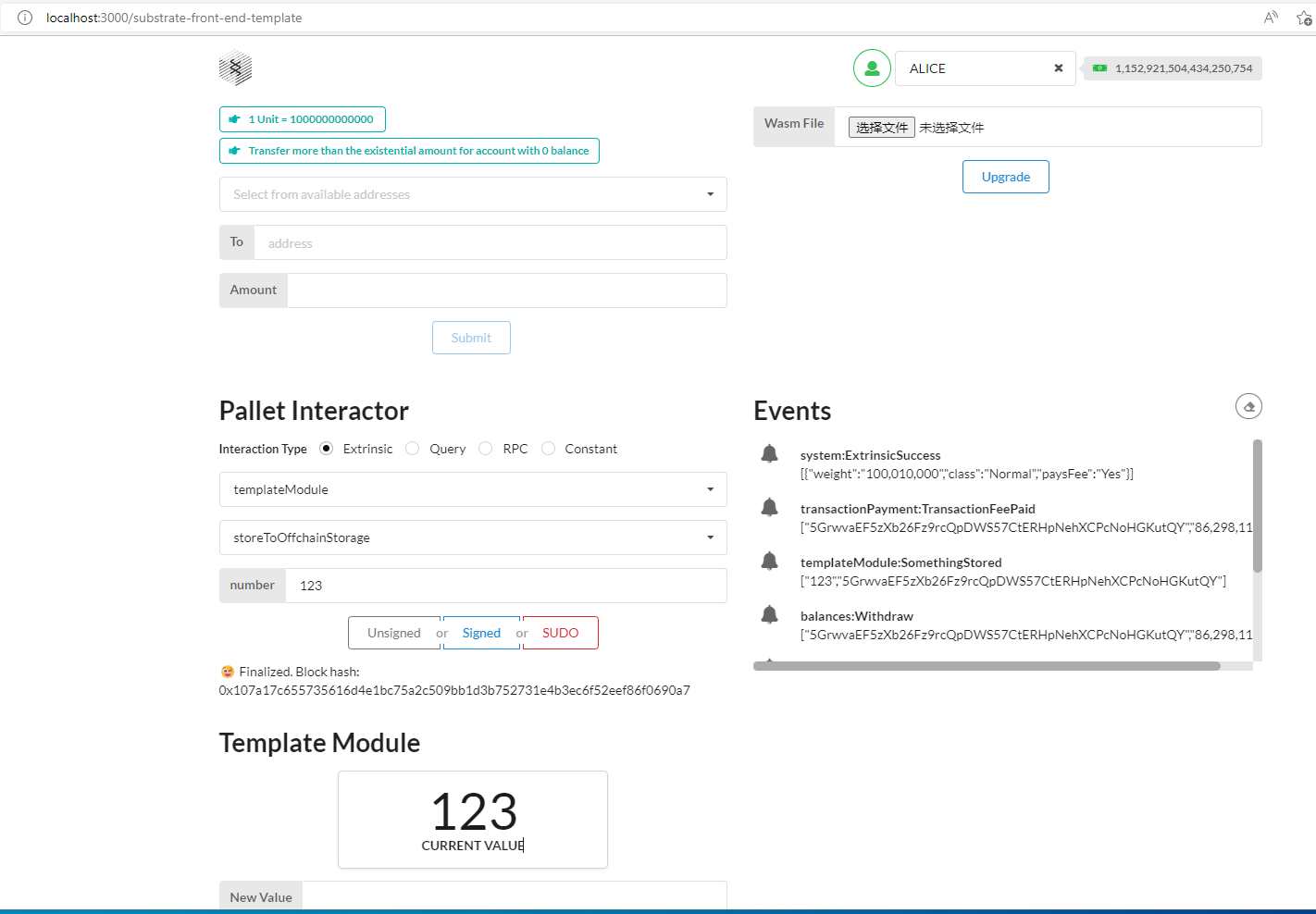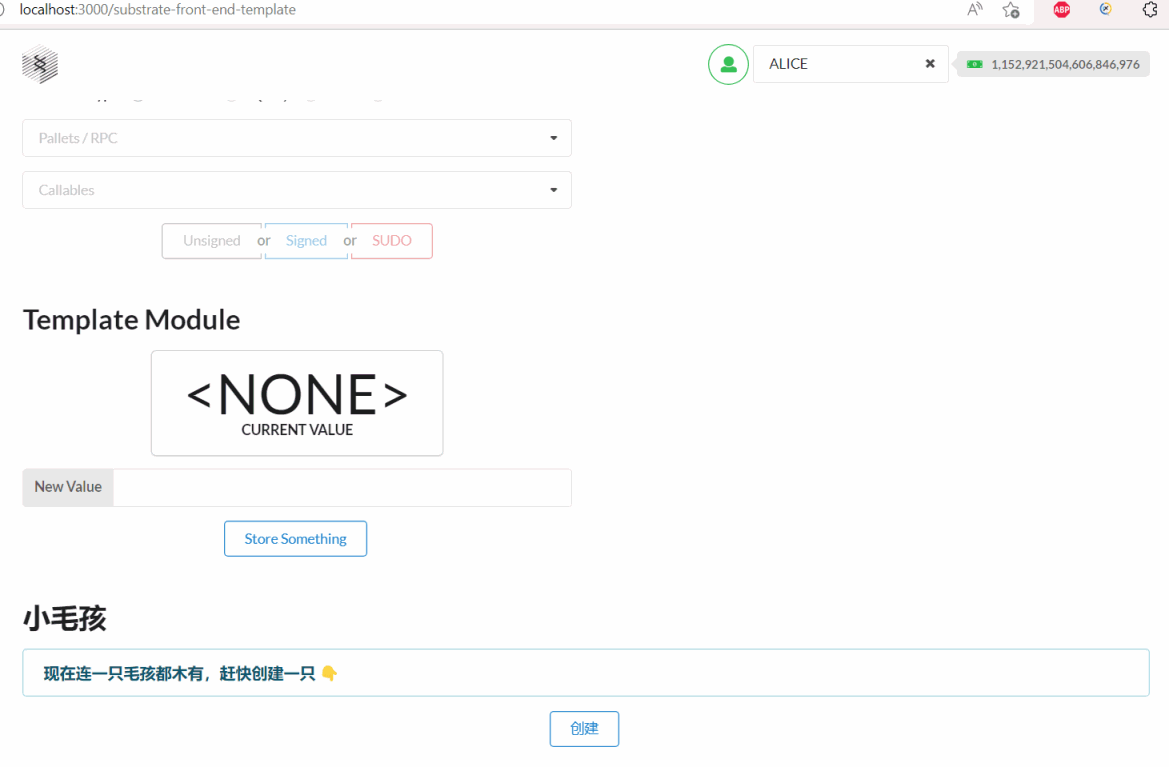使用 js sdk 从浏览器 frontend 获取到前面写入 Offchain Storage 的数据、
在pallet-template 中增加storeToOffchainStorage的extrinsic,使用offchain worker读出后调用do_something提交交易至链上,重用template的界面显示数据

This template allows you to create a front-end application that connects to a Substrate node back-end with minimal configuration. To learn about Substrate itself, visit the Substrate Documentation.
The template is built with Create React App and Polkadot js API. Familiarity with these tools will be helpful, but the template strives to be self-explanatory.
The codebase is installed using git and yarn. This tutorial assumes you have installed yarn globally prior to installing it within the subdirectories. For the most recent version and how to install yarn, please refer to Yarn documentation and installation guides.
# Clone the repository
git clone https://github.com/substrate-developer-hub/substrate-front-end-template.git
cd substrate-front-end-template
yarn installYou can start the template in development mode to connect to a locally running node
yarn startYou can also build the app in production mode,
yarn buildand open build/index.html in your favorite browser.
Connecting to Polkadot:
https://substrate-developer-hub.github.io/substrate-front-end-template?rpc=wss://rpc.polkadot.io
Connecting to your local Substrate node (Chrome and Firefox only):
https://substrate-developer-hub.github.io/substrate-front-end-template?rpc=ws://localhost:9944
Connecting to the development Substrate node wss://dev-node.substrate.dev:
https://substrate-developer-hub.github.io/substrate-front-end-template
The template's configuration is stored in the src/config directory, with
common.json being loaded first, then the environment-specific json file,
and finally environment variables, with precedence.
development.jsonaffects the development environmenttest.jsonaffects the test environment, triggered inyarn testcommand.production.jsonaffects the production environment, triggered inyarn buildcommand.
Some environment variables are read and integrated in the template config object,
including:
REACT_APP_PROVIDER_SOCKEToverridingconfig[PROVIDER_SOCKET]
More on React environment variables.
When writing and deploying your own front end, you should configure:
PROVIDER_SOCKETinsrc/config/production.jsonpointing to your own deployed node.
There are two ways to specify it:
- With
PROVIDER_SOCKETin{common, development, production}.json. - With
rpc=<ws or wss connection>query parameter after the URL. This overrides the above setting.
The custom hook useSubstrate() provides access to the Polkadot js API and thus the
keyring and the blockchain itself. Specifically it exposes this API.
{
setCurrentAccount: func(acct) {...}
state: {
socket,
keyring,
keyringState,
api,
apiState,
currentAccount
}
}socket- The remote provider socket it is connecting to.keyring- A keyring of accounts available to the user.keyringState- One of"READY"or"ERROR"states.keyringis valid only whenkeyringState === "READY".api- The remote api to the connected node.apiState- One of"CONNECTING","READY", or"ERROR"states.apiis valid only whenapiState === "READY".currentAccount- The current selected account pair in the application context.setCurrentAccount- Function to update thecurrentAccountvalue in the application context.
If you are only interested in reading the state, there is a shorthand useSubstrateState() just to retrieve the state.
The TxButton handles basic query and transaction requests to the connected node. You can reuse this component for a wide variety of queries and transactions. See src/Transfer.js for a transaction example and src/Balances.js for a query example.
The Account Selector provides the user with a unified way to select their account from a keyring. If the Balances module is installed in the runtime, it also displays the user's token balance. It is included in the template already.
-
Polkadot-js API and related crypto libraries depend on
BigIntthat is only supported by modern browsers. To ensure that react-scripts properly transpile your webapp code, update thepackage.jsonfile:{ "browserslist": { "production": [ ">0.2%", "not ie <= 99", "not android <= 4.4.4", "not dead", "not op_mini all" ] } }Refer to this doc page.
